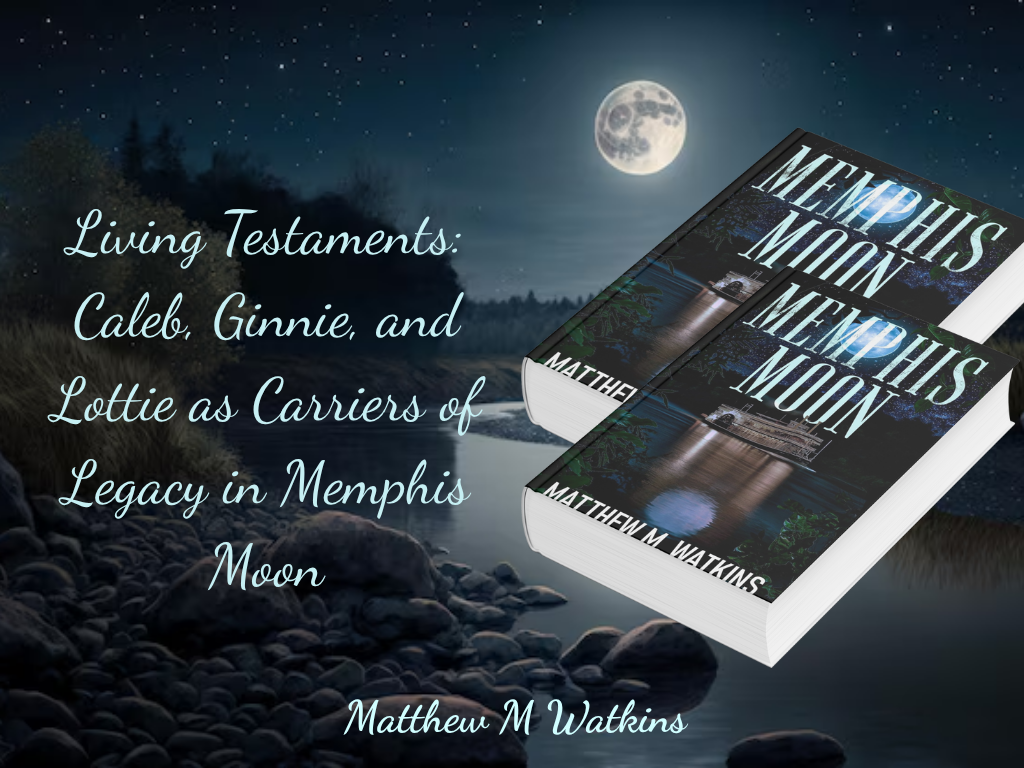In Memphis Moon, Matthew M. Watkins builds his story on the fragile but enduring thread that connects generations, the way human experience is passed not only through bloodlines but through compassion, memory, and faith. At the heart of this transmission are three characters: Caleb Dawkins, Ginnie Moon, and Lottie Moon. Together, they form the living architecture of legacy in the novel, each one carrying a different fragment of what it means to endure.
Caleb Dawkins’s story begins in loss. When the war strips away his family and home, he’s left standing amid the rubble, the past heavy on his shoulders. Watkins never turns Caleb into a symbol; instead, he allows him to be achingly human, a young man struggling to rebuild not only his father’s gristmill but also his sense of self. In Caleb, Watkins explores how legacy can begin as a burden. The weight of memory is not always gentle; sometimes it presses down before it lifts you up. Yet through his quiet persistence, Caleb transforms his inheritance of pain into an act of creation. His rebuilding becomes a form of remembrance, a promise to those who came before that their work, their love, their faith will not be forgotten.
If Caleb represents the endurance of action, Ginnie Moon embodies the endurance of voice. Her diary, hidden away for over a century, is the heartbeat of the entire novel. Through her words, readers glimpse not only her courage but her vulnerability, her contradictions, and her determination to define her own truth in a world torn apart by war. Watkins presents Ginnie not as an idealized heroine but as a woman who uses language to resist erasure. Her writing is her rebellion, her way of ensuring that what she felt, believed, and suffered would not vanish into silence. When her diary is finally discovered, it doesn’t just recount history; it resurrects it.
The rediscovery of Ginnie’s voice by the modern writer in the novel reflects Watkins’s larger idea: that legacy depends on both preservation and rediscovery. The past cannot speak unless someone is willing to listen. Ginnie’s words survive because someone, generations later, cared enough to read them. That act of connection, across time, across silence, is what gives her story new life.
Then there is Lottie Moon, whose presence in the narrative grounds it in faith and service. While Ginnie’s legacy is carried in ink and Caleb’s in labor, Lottie’s endures through compassion. She is not untouched by the cruelty of her time, yet she meets it with steadfast kindness. Watkins uses her story to remind readers that legacy can also be lived through character, through the daily choices to care, to give, to heal. Lottie’s strength lies not in grand gestures but in constancy. She teaches that what survives of us is often not what we build or write, but how we love.
Together, Caleb, Ginnie, and Lottie reveal the different dimensions of what Watkins means by “legacy.” It isn’t a single, static idea; it’s fluid, personal, and deeply emotional. Caleb keeps the past alive through reconstruction, Ginnie through storytelling, and Lottie through compassion. Their paths intertwine to form a collective memory that outlives them all.
Watkins’s decision to anchor his novel in these characters, drawn from history but rendered with emotional precision, allows Memphis Moon to move beyond the boundaries of historical fiction. It’s not about victory or defeat, but about survival through empathy.
By the final pages, the reader feels the continuity between them, how Caleb’s perseverance echoes Ginnie’s voice, how Ginnie’s courage echoes Lottie’s faith, how all three echo the author’s own reverence for memory. Through them, Watkins reminds us that legacy isn’t a monument cast in stone. It’s something softer, more intimate, a story, a kindness, a reconstruction that carries forward what might otherwise have been lost.
Memphis Moon asks its readers to remember that every act of care, every written word, every rebuilt thing is a way of saying: we were here, and we mattered. That is the essence of the legacy its characters leave behind.

